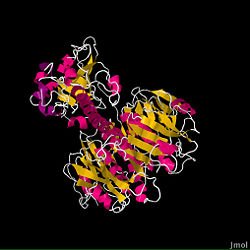User:Dan Huettner/Sandbox 2
From Proteopedia
Contents |
CHOLERA TOXIN
Introduction
The Cholera Toxin is released by the pathogen Vibrio cholerae during colonization of the small intestine. The genus Vibrio typically contains water organisms that are mainly found in salt water; however, there are few that can grow in freshwater. These organisms use glucose as their main energy and fuel source, while using flagella for locomotion. There are three different toxins from Vibrio cholerae that can result in Cholera: Cholera toxin, Zonula Occludens Toxin, and Accessory Cholera Enterotoxin.
The Cholera Toxin is transmitted by the intake of 'Escherichia coli'. After the bacteria is ingested, the Cholera Toxin is released and infects the small intestines, leading to the Cholera disease. Excessive diarrhea and vomiting ensues soon after ingestion, and death can occur within a few hours. Cholera is widespread in mainly poverty-stricken areas where food and water environments are unsanitary. It is a major problem in Africa, Asia, and Latin America, leading to 3-5 million cases and 100,000-200,000 deaths every year. Furthermore, Cholera is becoming increasingly dangerous with global warming, which creates a favorable environment for the pathogen.

